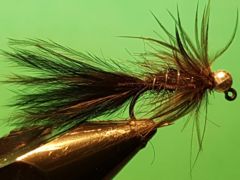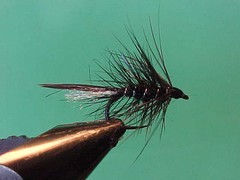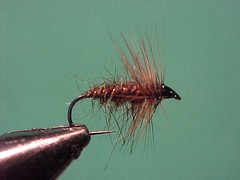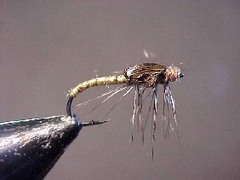Posts Tagged ‘tasmania’
{{start}}
{{end}}

{{+1}}Silver TBH CDC black/red MKII fuzzel bugger{{-1}}
{{start}}
MKII woolly buggers without any weight are amongst my favourite top dropper flies when loch style fly fishing in lakes and these smaller versions with a silver tungsten bead are up there amongst my favourite river flies.{{end}}

{{+1}}Silver TBH CDC black sparkle fuzzel bugger{{-1}}
{{start}}
This one of the 4 colours of TBH jig buggers that I carry in my river fly box. It's a great buggy looking fly that sink well and swims hook point up so less likely to get hooked up on the bottom othan flies that swim hook point down.{{end}}

{{+1}}Duracell jig nymph{{-1}}
{{start}}
I was attracted to this fly because it is made of two of my favourite fly tying materials UV Ice dubbing and CDC. It has looked like a winner since I first saw this fly and it has not let me down. Designed by, as I understand it, Craig McDonald it is a very popular fly in Europe and fast developing a following in Australia and New Zealand.{{end}}

{{+1}}BH silver surfer{{-1}}
{{start}}
I was ripping the black tailed version of this fly through the chop with some success when my boat partner asked what fly is that 'silver surfer'. I explained to him that it was just a woolly bugger variant tied with a black tail and silver UV straggle fritz. I tried to give it a real name such as 'silver woolly bugger' but unfortunately 'silver surfer' has stuck.{{end}}

{{+1}}White arse black zulu{{-1}}
{{start}}
The Zulu tied with a black hackle body and a black tail has origins that go back to circa 1600 England. This fly deviates from the standard a little and has a white under-tail of antron tied in to represents a trailing shuck, seals fur dubbing and a soft hackle at the front so if it is used as a loch fly it has some movement and a couple of trigger points.{{end}}

{{+1}}Bobs bits{{-1}}
{{start}}
I was told it was made from 'bits' and 'bobs' from off the fly tying bench and that it was therefor called a Bob's bits. I don't know if that is the true origin of the bobs bits fly but that is exactly how I make it. A bit of seals fur dubbing and a bit of whatever hackle is left on the bench. Just a couple of steps to tie it has heaps of applications in rivers and still water.{{end}}

{{+1}}Rising midge{{-1}}
{{start}}
This fly is designed to be fished on the drop and then on the rise. It was originally designed to imitate the action of lake Jindabyne olive midges as they hatched but it has proven useful in other fisheries.{{end}}

{{+1}}Matuka variant{{-1}}
{{start}}
Developed in New Zealand to represent a small fish Matuka style flies were originally tied with feathers from a kind of heron called a "bittern" or in the Maoris language "Matuka". They work well as a stripping fly in situations where bait fish may be on the menu and the most popular colours in Australia is black / red and brown / brown.{{end}}













